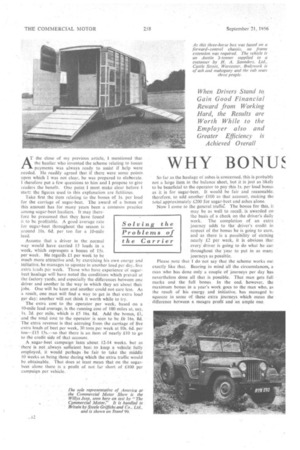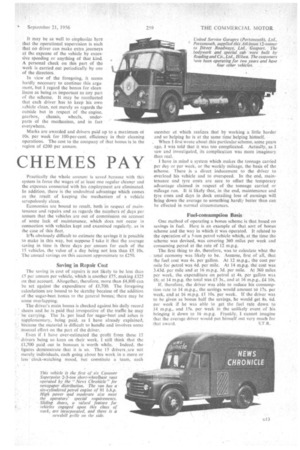WHY BONU S
Page 130

Page 131

If you've noticed an error in this article please click here to report it so we can fix it.
CHEMES PAY
ATthe close of my previous article, 1 mentioned that the haulier who invented the scheme relating to bonus payments was always ready to assist if help were
needed. He readily agreed that if there were some points upon which 1 was not clear, he was prepared to elaborate. I therefore put a few questions to him and I propose to give readers the benefit. One point I must make clear before I start: the figures used in this explanation are fictitious.
Take first the item relating to the bonus of is. per load for the carriage of sugar-beet. The award of a bonus of this amount has for many years been a common practice among sugar-beet hauliers. It may therefore be presumed that they have found It to be profitable. A good average rate for sugar-beet throughout the season is around 10s. 6d. per ton for a I0-mile lead.
Assume that a driver in the normal way would have carried 15 loads in a
week, which represents a bonus of 15s.
per week. He regards il per week to be much more attractive and, by exercising his own energy and
initiative, he manages to squeeze in another load per day, five extra loads per week. Those who have experience of sugarbeet haulage will have noted the conditions which prevail at the factory yards, and especially the differences between one driver and another in the way in which they set about theii jobs. One will be keen and another could not care less. As a result, one man will find a way to get in that extra load per day; another will not think it worth while to try.
The extra cost to the operator per week, based on a 10-mile lead average, is the running cost of 100 miles at, say,
Is. 2d. per mile, which is £5 16s. 8d. Add the bonus. El,
and the total cost to the operator is seen to be £6 I6s. 8d. The extra revenue is that accruing from the carriage of five
extra loads of beet per week, 30 tons per week at 10s. 6d. per too—£15 15s.7—so that there is an item of nearly £10 to go to the credit side of that account.
A .sugar-beet campaign -lastsabout 12-14 weeks, but as there is not ;always .sufficient. beei..to keep a vehicle fully employed, it would perhaps be fair to take the middle 10 weeks as being those during which the extra traffic would be obtainable. That does at least mean that on the sugarbeet alone there is a profit of not far short of £100 per campaign per vehicle.. • • So far as the haulage of ashes is concerned, this is probably not a large item in the balance sheet, but it is just as likely to he beneficial to the operator to pay this Is. per load bonth. as it is for sugar-beet. It would he fair and reasonable. therefore, to add another £100 to that account, making the total approximately £200 for sugar-beet and ashes atone.
Now I come to the general traffic. The bonus for this, it may be as well to recall. is awarded on the basis of a check on the driver's daily work. The completion of an extra journey adds to the driver's credit in respect of the bonus hi is going to earn, and as there is a possibility of earning nearly £2 per week, it is obvious that every. driver is going to do what he can throughout the year to put in as many journeys as possible.
Please note that I do not say that the scheme works out exactly like that. Bearing in mind all the circumstances, a man who has done only a couple of journeys per day has nevertheless done all that is possible. That man gets full • marks and the full bonus In the end, however, the maximum bonus in a year's work goes to the man who, as the result of his energy. and initiative, has managed to squeeze in some of these extra journeys which mean the difference between a meagre profit and an ample one.
It may be as well to emphasize here that the operational supervision is such that no driver can make extra journeys at the expense of the vehicle by excessive speeding or anything of that kind. A personal check on this part of the work is carried out periodically by one of the directors.
in view of the foregoing, it seems hardly necessary to continue this argu merit, but I regard the bonus for cleanliness as being as important as any part of the scheme. It may be recollected that each driver has to keep his own vehicle clean, not merely as regards the outside but in respect of the engine, gearbox, chassis, wheels, underparts of the mechanism, and in fact everywhere.
Marks are awarded and drivers paid up to a maximum of 10s. per week for 100-per-cent efficiency in their cleaning operations. The cost to the company of that bonus is in the region of £200 per annum.
Practically the whole amount is saved because with this system in force the wages of at least one regular cleaner and the expenses connected with his employment are eliminated. In addition, there is the undoubted advantage which comes as the result of keeping the mechanism of a vehicle scrupulously clean.
Economies are bound to result, both in respect of maintenance and repairs and as regards the numbers or .days per annum that the vehicles arc out of commission on account of some lack of maintenance, which does not occur in connection with vehicles kept and examined regularly, as in the case of this fleet.
Its obviously difficult to estimate the savings it is posSible to make in this way, but suppose I take it that the average saving in time is three days per annum for each of the 15 vehicles, the value of a day being not less than £5 10s. The annual sayings on this account approximate to £250.
Saving in Repair Cost
The saving in cost of repairs is not likely to be less than £5 per annum per vehicle, which is another £75, making £325 on that account. Altogether, therefore, more than £4,800 can be set against the expenditure of £1,700. The foregoing calculations are bound to be sketchy because of the addition of the sugar-beet bontis to the general bonus; there may be some overlapping.
The driver's main bonus is checked against his daily record sheets and he is paid that irrespective of the traffic he may • be carrying. The Is. per load for sugar-beet and ashes is supplementary, being paid, as 1 have already explained, . because the material is difficult to handle and involves some manual effort on the part of the driver.
Even if I have over-estimated the profit from these 15 drivers being so keen on their work, I still think that the
£1,700 paid out in bonuses is worth while. Indeed, the figures demOnstrate that it is so. The 15 drivers .are not merely individuals, each going about his work in a more of less• clock-watching mood, but constitute a team, each member of which realizes that by working a little harder and so helping he is at the same time helping hirriseIf.
When I first wrote about this particular scheme, some years ago, I was told that it was too complicated. Actually, as I saw and investigated, its complication was more imaginary than real.
I have in mind a system which makes the tonnage carried per day or per week, or the weekly mileage, the basis of the scheme. There is a direct inducement to the driver to overload his vehicle and to overspeed. In the end, maintenance and tyre costs are sure to offset the temporary advantage claimed in respect of the tonnage carried or mileage run. It iS 'likely that, in the end, maintenance and tyre costs and days in dock entailing loss of earnings will bring down the average to something hardly better than can be effected in normal circumstances, Fuel-consumption Basis
One method of operating a bonus scheme is that based on savings in fuel. Here is an example of that sort of bonus scheme and the way in which it was operated. It related to the operation of a 5-ton petrol vehicle which, at the time the scheme was devised, was covering 360 miles per week and consuming petrol at the rate of 12 m.p.g.
The first thing to do, therefore, was to calculate what the total economy was likely to he. Assume, first of -all, that the fuel. cost was 4s per gallon. At 12 m.p.g., the cost per mile for petrol was 4d. per mile. At 14 m.p.g. the cost was 3.43d. per mile and at 16 m.p.g. 3d. per mile, At 360 miles per week, the expenditure on petrol at 4s. per gallon was £6: at 14 m.p.g. the total was £5 3s., and at 16 m.p.g., £4 10s.
If, therefore, the driver was able to reduce his consumption rate to 14 m.p.g., the savings would amount to I7s. per week, and at 16 m.p.g. £1 105. per week, If the driver was to be given as bonus half the savings, he would get 8s. 6d, per week if he was able to get the fuel rate down to 14 m.p.g.. and 15s. per week in the unlikely event of his bringing it down to 16 m.p.g. Frankly, I cannot imagine that the average driver would put himself out very much for
that award. S.T.R.




































































































































































































































































































































